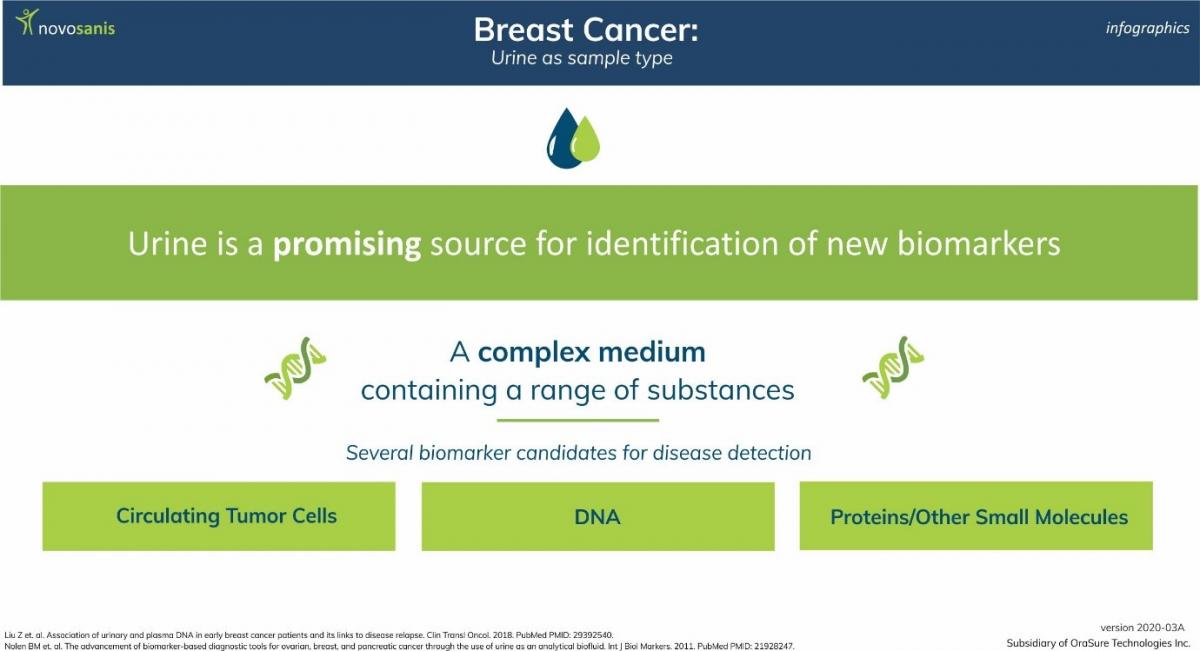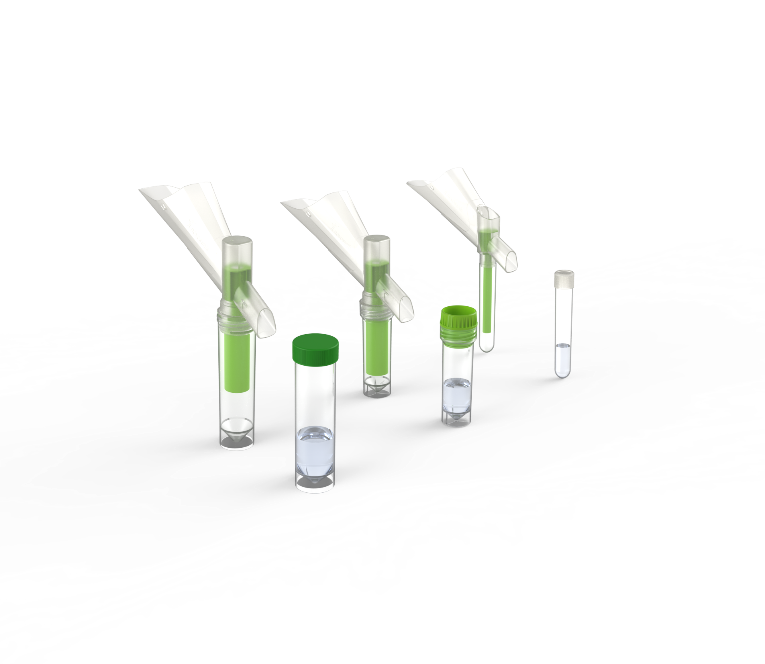URODETECT
You are here

Liquid biopsy – Urine as a sample type
Screening and early detection of cancer are important to prevent morbidity and mortality. A tissue biopsy is the traditional approach to diagnose many cancers forms. However, this procedure is not always feasible and can be painful, expensive, invasive as well as difficult to perform (1).
As a result, minimally invasive procedures such as liquid biopsies, that search for biomarkers, measurable substances whose presence or lack of can indicate disease, are gaining interest (1). Circulating molecules like cell-free DNA, tumor cells, RNA, proteins, peptides and exosomes in biological fluids such as plasma, saliva, serum and urine can be used as biomarkers for disease detection.
Liquid biopsies have several advantages - they allow repeat sampling, are associated with less complications and are less invasive than traditional biopsies (1).
While plasma (blood) testing is typically the most common liquid biopsy, urine as a sample type offers several benefits over blood. It is easily accessible, non-invasive, and can be available in larger quantities (2). Moreover, urine sampling does not hold any risk of transmission of blood-borne pathogens (3).
Studies have shown the potential of urine for several cancers, including prostate and breast cancer research.
Want to learn more about urine as a liquid biopsy: Click here:
Prostate Cancer and Urine
Prostate Cancer is the most common cancer in men in developed countries (4). The 5-year survival rate for men with local or regional prostate cancer is nearly 100%. Alternatively, for men where the disease has spread to other parts of the body, the survival rate can drop up to 31% (5), highlighting the importance of screening and early detection.
Increased levels of Prostate Specific Antigen (PSA), a protein found in blood is the most common method to detect prostate cancer. However, PSA testing has low sensitivity and specificity, and other conditions can also result in elevated PSA levels, resulting in overdiagnosis and overtreatment. Additionally, for some prostate cancer types, men do not display higher levels of PSA (6).
Recent studies have shown urine as a promising source of biomarkers for early detection and prediction of prostate cancer. With prostate manipulation, biomarkers for prostate cancer including prostate cancer cells, DNA, RNA, proteins and other small molecules can be released into urine (7).
To avoid dilution of prostate cancer biomarkers, collecting first-void or first-catch urine (first 20ml of urine flow) is important and can be more effective than a midstream sample (8,9).
Want to learn more about prostate cancer and urine: Click here:

Breast Cancer and Urine
Breast Cancer is the leading cause of cancer death in women worldwide (10).
Current methods to screen for breast cancer include a mammography, which takes images of the breast with an x-ray (10). While screening efforts have been implemented, the effectiveness of a mammography varies with age, with an overall sensitivity of 75% (11), but only around 54-58% in women younger than 40 (2). As a result, alternative methods to screen for breast cancer are needed. Urine contains potential biomarkers for breast cancer. Additionally, urinary DNA has shown possibilities to measure breast cancer severity and help predict disease relapse (12,13).

URODETECT
Aim:
Given the challenges in screening and early detection and the possibility of urine as a potential sample type to improve cancer research, this PhD project, titled Urine as a liquid biopsy for cancer detection (URODETECT), will focus on the two most common cancer types in male and females, prostate and breast cancer respectively.

To truly exploit the potential of urine as a liquid biopsy, optimal urine collection methods and storage conditions for biomarker detection are required.
Colli-Pee®, a device developed by Novosanis, has proved to allow standardized and volumetric collection of first-void urine.
The project will focus on investigating and isolating urinary biomarkers (cell-free nucleic acids, extracellular vesicles and proteins) using urine collected with Colli-Pee® platform.
Additionally, findings of the project will also help drive development of a new generation of the Colli-Pee® device that will further improve its applicability for oncology purposes.
Want to know more:
If you would like to participate in the study, or know more about URODETECT contact PhD student:
Stephanie Jordaens
stephanie.jordaens@uantwerpen.be
References:
(1) Di Meo A, Bartlett J, Cheng Y, Pasic MD, Yousef GM. Liquid biopsy: a step forward towards precision medicine in urologic malignancies. Mol Cancer. 2017;16(1):80.
(2) Nolen BM, Lokshin AE. The advancement of biomarker-based diagnostic tools for ovarian, breast, and pancreatic cancer through the use of urine as an analytical biofluid. Int J Biol Markers. 2011 Jul-Sep;26(3):141-52. doi: 10.5301/JBM.2011.8613. Epub 2011 Sep 21. Review. PubMed PMID: 21928247; PubMed Central PMCID: PMC4556600.
(3) CDC. The National Healthcare Safety Network (NHSN) Manual. 2013. USA
(4) Dijkstra S, Birker IL, Smit FP, Leyten GH, de Reijke TM, van Oort IM, Mulders PF, Jannink SA, Schalken JA. Prostate cancer biomarker profiles in urinary sediments and exosomes. J Urol. 2014 Apr;191(4):1132-8. doi: 10.1016/j.juro.2013.11.001. Epub 2013 Nov 7. PubMed PMID: 24211598.
(5) Cancer.Net Website - Prostate Cancer: Statistics - https://www.cancer.net/cancer-types/prostate-cancer/statistics
(6) Lima AR, Bastos Mde L, Carvalho M, Guedes de Pinho P. Biomarker Discovery in Human Prostate Cancer: an Update in Metabolomics Studies. Transl Oncol. 2016 Aug;9(4):357-70. doi: 10.1016/j.tranon.2016.05.004. Review. PubMed PMID: 27567960; PubMed Central PMCID: PMC5006818.
(7) Fujita K, Nonomura N. Urinary biomarkers of prostate cancer. Int J Urol. 2018 Sep;25(9):770-779. doi: 10.1111/iju.13734. Epub 2018 Aug 21. Review. PubMed PMID: 30129068.
(8) Hessels D, Schalken J. Urinary biomarkers for prostate cancer: a review. Asian J Androl. 2013 May 6; 15(3): 333–339. Published online 2013 Mar 25. doi: 10.1038/aja.2013.6. PMCID: PMC3739649
(9) Theodorescu D, Schiffer E, Bauer HW, Douwes F, Eichhorn F, Polley R, Schmidt T, Schöfer W, Zürbig P, Good DM, Coon JJ, Mischak H. Discovery and validation of urinary biomarkers for prostate cancer. Proteomics Clin Appl. 2008 Mar 7;2(4):556-570. doi: 10.1002/prca.200780082. PubMed PMID: 19759844; PubMed Central PMCID: PMC2744126.
(10) World Health Organization website - https://www.who.int/cancer/prevention/diagnosis-screening/breast-cancer/en/
(11) Carney PA, Miglioretti DL, Yankaskas BC, Kerlikowske K, Rosenberg R, Rutter CM, Geller BM, Abraham LA, Taplin SH, Dignan M, Cutter G, Ballard-Barbash R. Individual and combined effects of age, breast density, and hormone replacement therapy use on the accuracy of screening mammography. Ann Intern Med. 2003 Feb 4;138(3):168-75. doi: 10.7326/0003-4819-138-3200302040-00008. PubMed PMID: 12558355.
(12) Pories SE, Zurakowski D, Roy R, Lamb CC, Raza S, Exarhopoulos A, Scheib RG, Schumer S, Lenahan C, Borges V, Louis GW, Anand A, Isakovich N, Hirshfield-Bartek J, Wewer U, Lotz MM, Moses MA. Urinary metalloproteinases: noninvasive biomarkers for breast cancer risk assessment. Cancer Epidemiol Biomarkers Prev. 2008 May;17(5):1034-42. doi: 10.1158/1055-9965.EPI-070365. PubMed PMID: 18483323.
(13) Liu Z, Liu W. Association of urinary and plasma DNA in early breast cancer patients and its links to disease relapse. Clin Transl Oncol. 2018 Aug;20(8):1053-1060. doi: 10.1007/s12094-017-1825-9. Epub 2018 Feb 1. PubMed PMID: 29392540.
